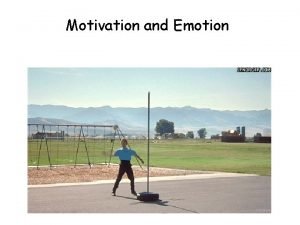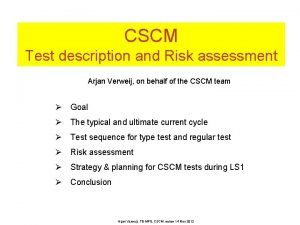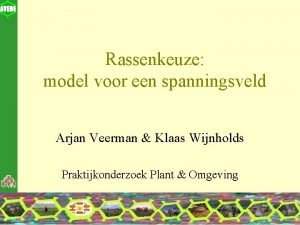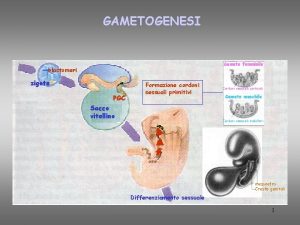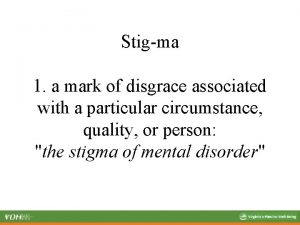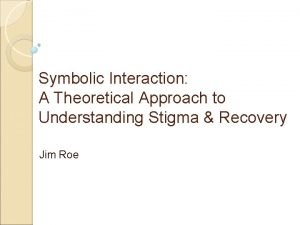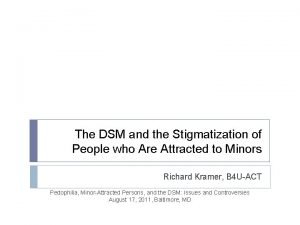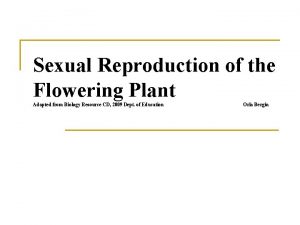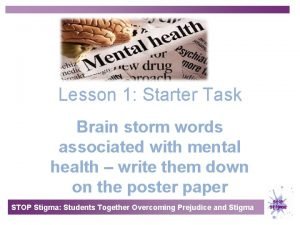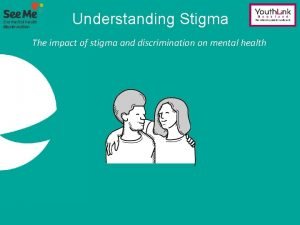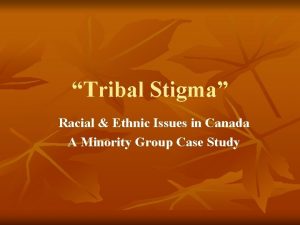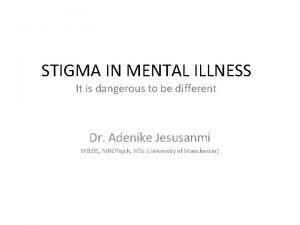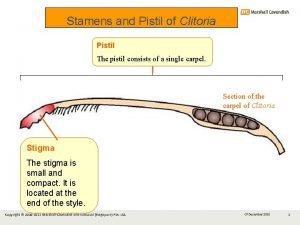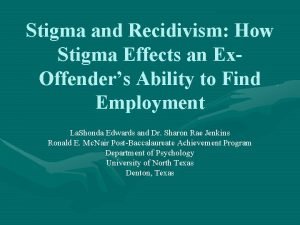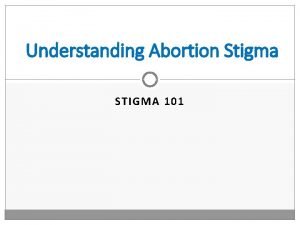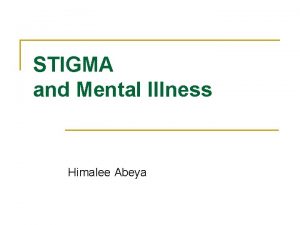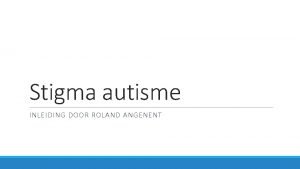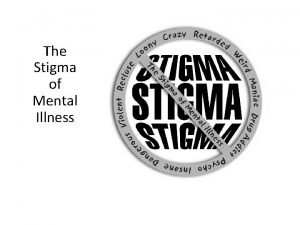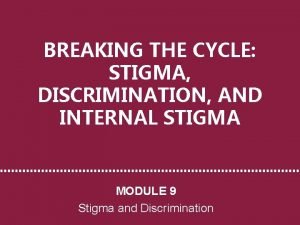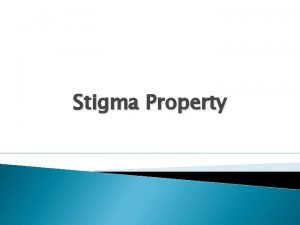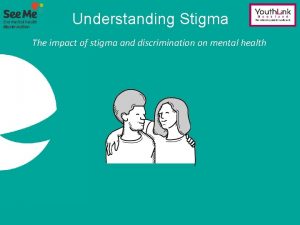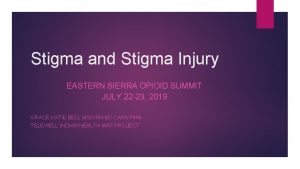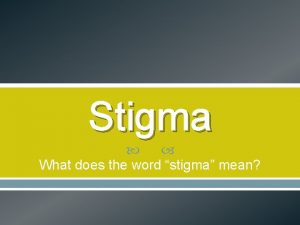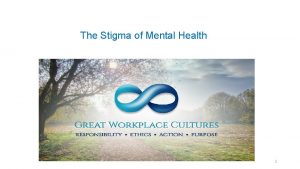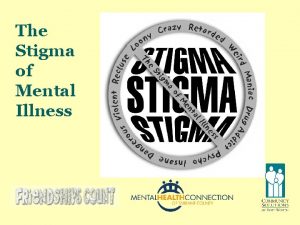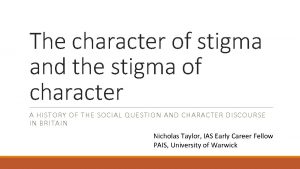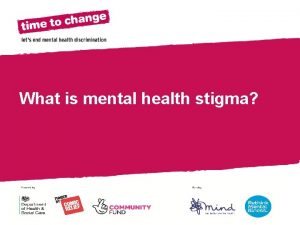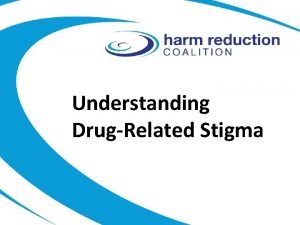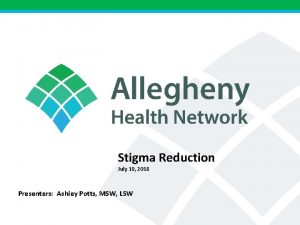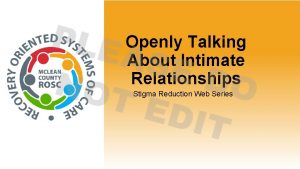Stigma Reduction From Theory to Interventions Arjan E


























- Slides: 26

Stigma Reduction From Theory to Interventions Arjan E. R. Bos & Sarah E. Stutterheim

A definition of stigma An attribute that results in widespread social disapproval A discrediting social difference that yields a “spoiled social identity” Two fundamental components: - recognition of difference - devaluation

Four different types of stigma

Public stigma People’s social and psychological reactions to someone they perceive to have a stigmatized condition. Public stigma comprises cognitive, affective, and behavioral reactions of those who stigmatize.

Self-stigma Social and psychological impact of possessing a stigma. It includes both the apprehension of being exposed to stigmatization and the potential internalization of the negative beliefs and feelings associated with the stigmatized condition.

Stigma-by-association Social and psychological reactions to people who are somehow associated with a stigmatized person or how people react to being associated with a stigmatized person

Structural stigma Legitimatization and perpetuation of a stigmatized status by society’s institutions and ideological systems

Designing theory and evidence-based stigma interventions

Intervention Mapping

Step 1: Needs assessment Experiences with hiv-related stigma in the health care sector (N = 667): Dentist 28. 8% Hospital 26. 2% General practitioner 19. 2%

Step 1: Needs assessment Manifestations of hiv-related stigma in the health care sector (N = 262): Advice to conceal 25. 2% Physical distance 20. 6% Excessive protective measures 20. 6% Differential protective measures 16. 8% Àdvice to disclose 14. 9% Breached confidentiality 13. 7% Awkward social interaction 12. 6% Care avoidance 11. 8% Rude and unkind behavior 10. 7% Blame 10. 3% Sympathy and support 76. 3%

Step 1: Needs assessment Interviews with Health professionals (N = 14) Little experience with PLWH and only basic knowledge of HIV. They contended that PLWH are treated equally and that HIV is no longer stigmatized. However, they also reported fear of occupational infection, resulting in differential precautions. Additionally, they conveyed labeling PLWH’s files to warn others, and curiosity regarding how patients acquired HIV.

Step 1: Needs assessment Interviews with persons living with hiv (N = 22) Negative experiences with health professionals: Awkward interactions, irrelevant questions, rude treatment, blame, pity, excessive or differential precautions, care refusal, unnecessary referrals, delayed treatment, poor support, and confidentiality breaches. Positive experiences with health professionals: Equal treatment, being valued as a partner in one’s health, social support provision, and confidentiality assurances.

Step 2: Define suitable programme objectives Health professionals will interact with all HIV positive patients in a nonstigmatizing fashion Health professionals will interact with all HIV positive colleagues in a nonstigmatizing fashion

Step 2: Define suitable programme objectives Persons living with hiv will be empowered in their interactions with health professionals Persons living with hiv will be resilient against the negative effects of perceived HIV-related stigma from health professionals

Step 3: Select theory-based intervention methods and practical strategies Intervention methods are general techniques or processes that can generate change in behaviors or environments (e. g. , modeling, interpersonal contact, persuasive communication, consciousness raising Practical strategies are specific techniques used to apply theoretical methods (e. g. testimonials, written information).

Step 3: Select theory-based intervention methods and practical strategies Changing public stigma: - Education - Contact Integration of education and contact approaches may be most effective for stigma change (Corrigan & Fong, 2014; Brown et al. , 2003)

Step 3: Select theory-based intervention methods and practical strategies Changing self-stigma: - Challenge stigmatizing selfstatements (psycho-educational strategies, CBT, ACT) - Interventions that enhance skills for coping with self-stigma through improvements in self-esteem, empowerment, and help-seeking behavior. (Corrigan & Fong, 2014; Mittal, Sullivan, Chekuri, Allee & Corrigan, 2012)

Step 3: Select theory-based intervention methods and practical strategies

Step 3: Select theory-based intervention methods and practical strategies

Step 4: Produce programme components and materials

Step 4: Produce programme components and materials

Step 5: Design an implementation plan Potential adopters and implementers present in the work group (at the start of the project). We tied into existing networks that could easily promote the website. Presented the website at the National HIV Conference and at the Nursing Experience conference, and sent out a press release prior to launching the site. We ensured that the website would remain online after the project’s funding ended by transferring ownership of the site to the Dutch HIV Association

Step 6: Design an evaluation plan Process evaluation - Reach and exposure (google analytics and vimeo statistics) - Interviews with health professionals and persons living with hiv (think-aloud approach while navigating the website) Results process evaluation provide relevant entry points for improving positiefzorgt. nl

Future directions

Questions? www. positiefzorgt. nl E-mail: Arjan. Bos@ou. nl Twitter: @arjanbos Web: https: //sites. google. com/site/arjanerbos
 Which of the following factors stimulate us to eat?
Which of the following factors stimulate us to eat? Arjan hogewoning
Arjan hogewoning Arjen van der horst
Arjen van der horst Arjan koning
Arjan koning Arjan van hessen
Arjan van hessen Arjan van hessen
Arjan van hessen Arjan baan evangelist
Arjan baan evangelist Arjan verweij
Arjan verweij Arjan veerman
Arjan veerman Arjan verweij
Arjan verweij Parts of green plants
Parts of green plants Stigma associated with failure and repetition is removed
Stigma associated with failure and repetition is removed Stigma ovaio
Stigma ovaio Epicotyl and hypocotyl
Epicotyl and hypocotyl The mark
The mark Stigma is a mark of disgrace
Stigma is a mark of disgrace Associatief stigma
Associatief stigma Anther and stigma
Anther and stigma Symbolic stigma
Symbolic stigma Stigma image
Stigma image Fruits and seeds formation
Fruits and seeds formation Stigma image
Stigma image Stigma bunga
Stigma bunga What is stigma
What is stigma Tribal stigma
Tribal stigma What is stigma
What is stigma Germination of pollen on stigma
Germination of pollen on stigma
